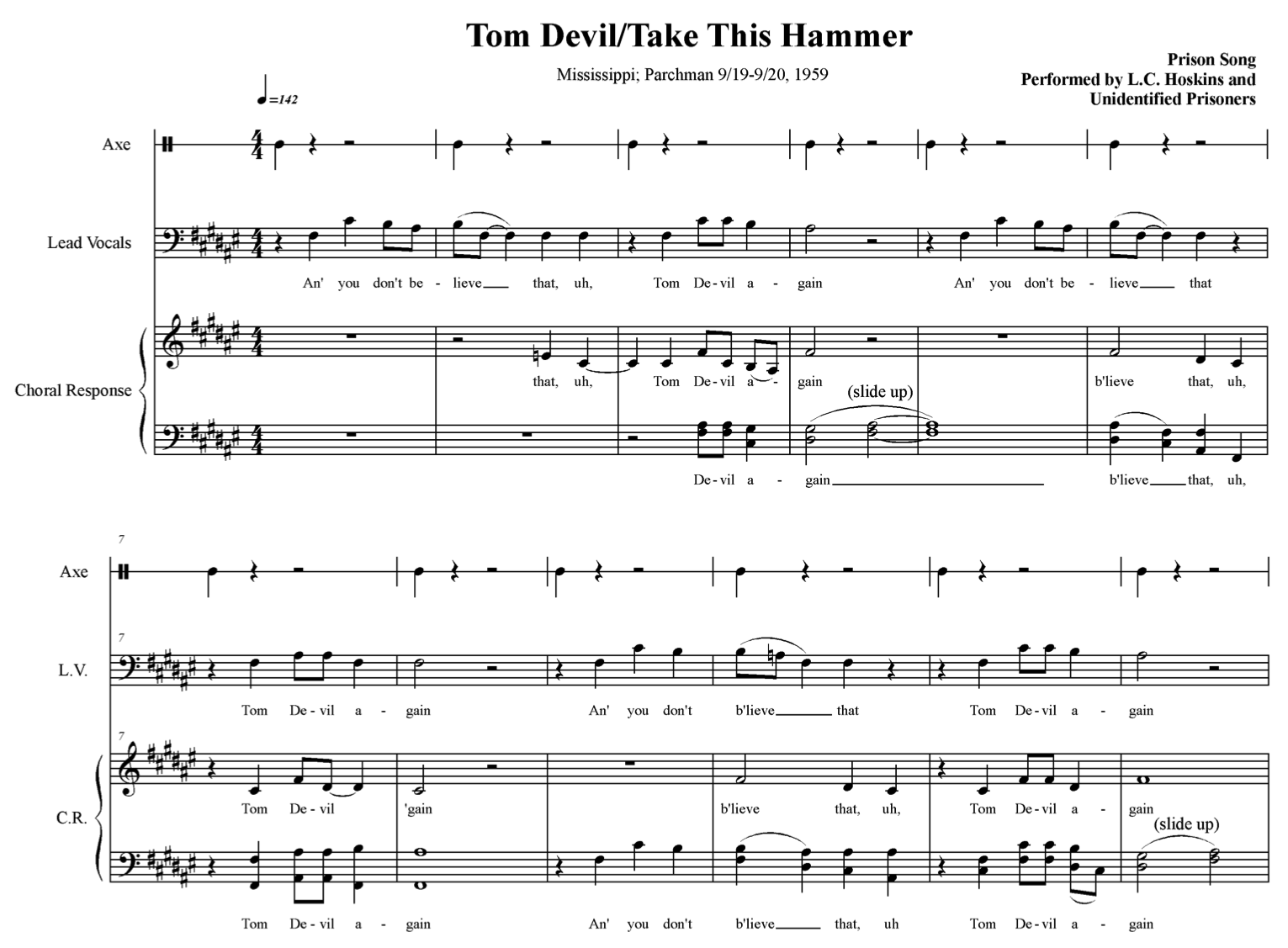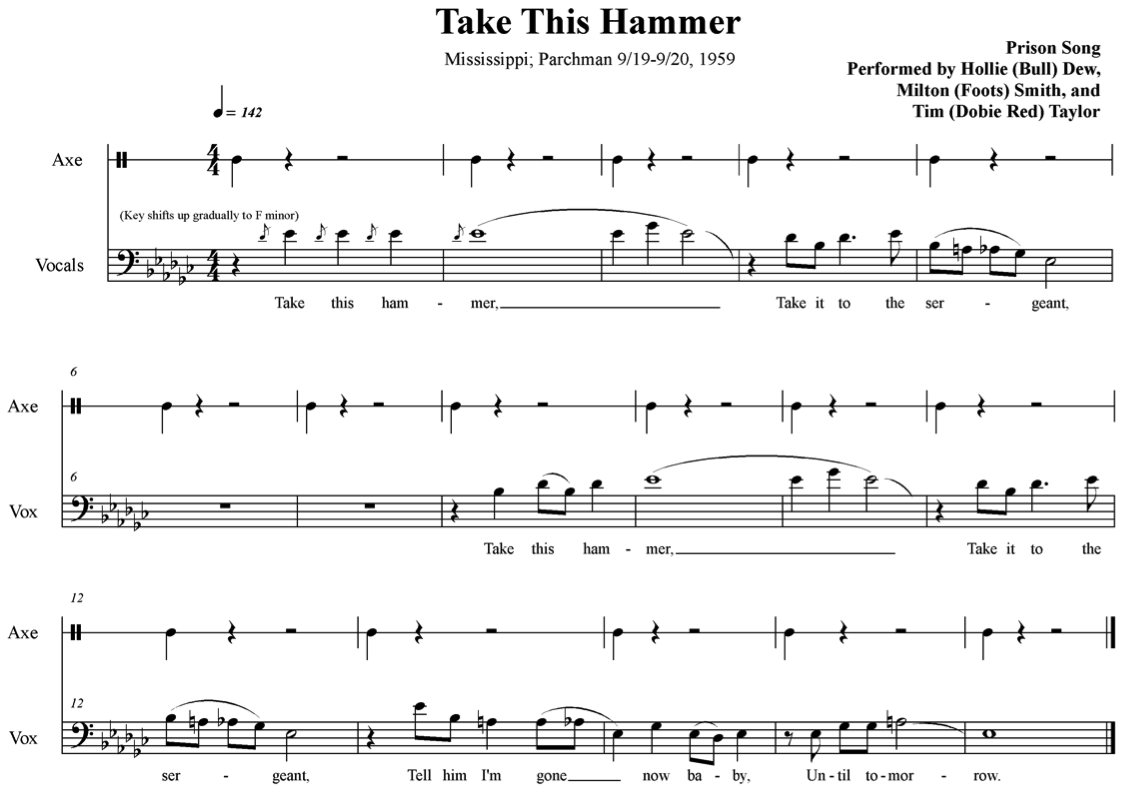Selection: Tom Devil / Take This Hammer
Recorded: Parchman Farm in Parchman, Mississippi, September 16, 1959
Performers: L. C. Hoskins and unidentified prisoners
Activity #1: The Swing, the Sentiment, and the Vocal Blend
1. Listen to the first 45 seconds of the recording after asking the following questions:
- What sounds do you hear? (Male vocals, axes)
- Can you determine anything about the context of the song? (Work song, sung by imprisoned men)
- Where do you think the recording is from? (Southern prison, Parchman Penitentiary in northern Mississippi)
2. Listen to the recording again and tap along to the beat quietly with one hand.
- Why is it hard to clap along at the beginning of the song before the voices enter (first 10 seconds)? (Because the axe ‘players’ are taking a moment to coordinate and create a collective beat)
- Did you find yourself marking a pulse in-between the beats in some way? If so, how might this align with the motions of the performers on the recording? (Sub-divisions of the main beat may coincide with the raising and swinging of the axes in unison)
3. In a third listening, challenge the students to use one hand to tap the main beat and the other hand to tap along to the collective vocal rhythm.
- While tapping or listening to the vocal rhythm, do you feel a strong main beat in each phrase (the feeling of “1”)? (Yes, and this could be counted in 4 or a twice-as-fast 8) Try to determine how this strong beat is marked (vocal phrasing leads into a strong beat that is marked by prominent held notes. These notes are sung collectively rather than just by one or two singers and the bass voices slide into the pitch for further emphasis)
4. Choose one verse and try to write out the words together for the whole class to see (the following verse starts at 3:10):
I jes don’t know her but I b’lieve I will
I jes don’t know her bit I b’lieve I will
I b’lieve I will I b’lieve I will
I make my home in a, a Jacksonville
5. Listen to the selected verse two more times. • Ask students to select a vocal part (in the multi-part harmony) to sing quietly while following along with the text written on the board. • On the second listening, do the same exercise but choose a different vocal part of the harmony of voices to sing along. 6. Discuss how the voices interact with one another. • How do the voices blend together? (They’re singing in multi-part harmony and they draw from the same text) • How can you distinguish one vocal part from another? (Although they all draw from the same text, you can distinguish different vocal parts from one another based on the segments of text that they choose to sing and the differences in their rhythmic phrasing of that text. The timbres of the higher voices stand out in the recording as well as the long-held notes of the bass voices.) 7. Share the notation of “Tom Devil/Take This Hammer”, and ask how the graphic notation offers a difference perspective on and understanding of the song. Between listening and reading the notation, challenge students to sing the song in a well-tuned harmony and with the rhythmic swing that is evident on the recording.


Note: Transcription by James B. Morford
Activity 2: Meaning and Value of a Penitentiary Song
1. Offer a description and brief history of the Mississippi Parchman Penitentiary.
- State penitentiary in Northwestern Mississippi (use map to point out location)
- Opened in the early 1900’s, was one of several ‘prison farms’ (prison still functioning today)
- Large, isolated plantation (several thousand acres) where prisoners were forced to work in cotton fields all day
- Violent guards abused prisoners
- Most imprisoned persons were African American men, largely because of a racially biased judicial system and society
- African American women also worked in the fields, but their main duty was to sew clothes and bedding for the entire farm (Oshinsky, plate 13)
- Example of a women’s work song (Ibid):
- You talkin bout trouble, you don’t know what trouble mean
You talkin bout trouble, you don’t know what trouble mean
What I call trouble is a Singer Sewing Machine
- Songs helped workers pass the time during long work hours, commentated on day-to-day experiences at Parchman Farm and offered an outlet of expression. Songs were humorous, playful, lustful and sorrowful and they expressed longing for past and future circumstances (Oshinsky 145-147). See Oshinsky, David M. 1996. Worse than slavery: Parchman Farm and the ordeal of Jim Crow justice. New York: Free Press.
2. Show the class some photos of Parchmen residents by Googling “Parchman Penitentiary” or referring to Oshinksky’s book (16 pages of photographs)
3. Although you may not be able to decipher every word, listen and write down the main themes that you hear in the song. (Note that song changes around 3:50 from “Tom Devil” to “Take This Hammer” and the following themes are from the first half of the song.)
*Tom Devil is dead
*Don’t you never pray
*I been calling Rosie for 5 long years
*Write me a letter in the sergeant’s care
*She won’t write me no letters won’t send me no words
*I get my message from the mockingbird
*I make my home in Jacksonville
4. Discuss the potential meaning of some of these themes based on what you know about Parchman.
For example, asking someone to “write a letter in the sergeant’s care” may be in reference to a prisoner asking the prison authorities to send an official pardon.
5. See the coordination of song and movement in this YouTube video set in the Parchman Penitentiary in the 1970’s.
Lesson Plan by Jocelyn Moon
